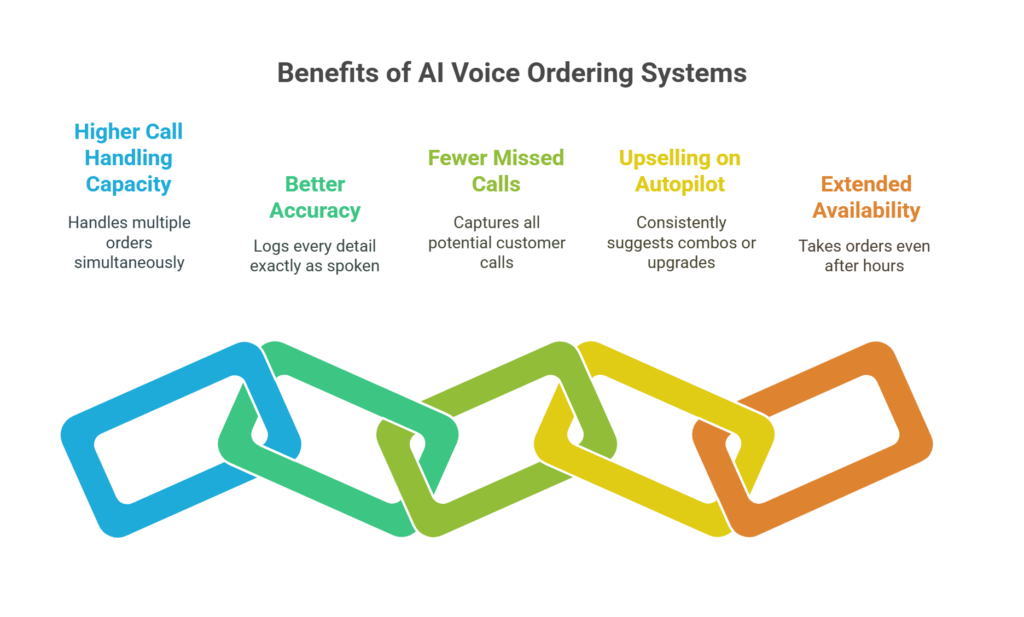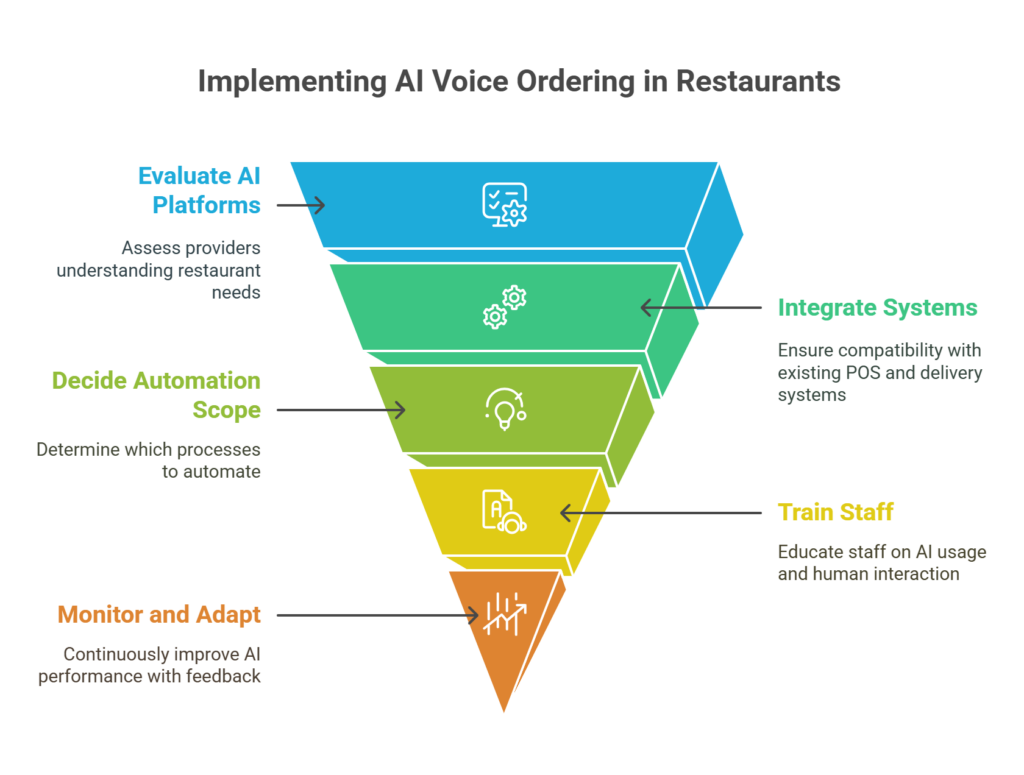It’s 2025, and today, restaurants can’t afford to run like it’s 2015. Phone lines are still jammed, customers still get put on hold, and staff still mishear orders during rush hour. That setup doesn’t scale anymore.
If you’re getting a good number of phone orders or even struggling to manage them during peak hours, it’s already costing you money. Not because your staff isn’t trying, but because they’re overwhelmed. That’s where an AI voice ordering system becomes more than just a cool tech upgrade. It becomes necessary.
How AI Voice Ordering Systems Are Benefiting Restaurants

Restaurant owners are starting to realize that voice ordering for restaurants isn’t about replacing human effort. It’s about refocusing it. Here’s what restaurants are actually getting out of it:
- Higher call handling capacity. While one staff member can take one order at a time, AI voice ordering systems can handle multiple orders simultaneously.
- Better accuracy. The system doesn’t mishear or forget instructions. It logs every detail exactly as spoken.
- Fewer missed calls = more revenue. Every missed call could be a lost customer. AI captures them all.
- Upselling on autopilot. The AI can consistently suggest combos or upgrades—without being pushy or forgetting.
- Extended availability. Even after hours, your voice ordering system can still take orders for the next day.
It’s helping restaurants stay lean without sacrificing service. That’s not a theory. That’s what’s actually happening.
How Does AI Voice Ordering Work for Restaurants?
The tech isn’t just smart. It’s surprisingly seamless.
- Customer calls your number.
- The AI voice assistant picks up, says a greeting you can customize, and asks for the order.
- The AI listens, understands, and confirms details.
- It sends the order to your kitchen or POS system.
The system uses natural language processing to understand customer speech, machine learning to improve its responses over time, and integrations to push orders directly into your operations.
No awkward pauses. No robotic tones. Just orders getting done faster.
How to Implement AI Voice Ordering Systems in Your Restaurant
You don’t need to be a tech expert to get this started. But you do need to follow a structure.

- Understand your problem. Are phone orders causing errors? Are customers getting frustrated waiting? Start there.
- Evaluate AI voice ordering platforms. Pick a provider that understands the restaurant space. It matters.
- Ensure it integrates with your existing systems. That includes your POS, KDS, and delivery stack.
- Decide what stays and what gets automated. You don’t have to do full automation from day one. Many restaurants use AI just for peak hours.
- Train your staff. Not just on how to use it, but on how to handle handoffs between AI and human interaction.
- Monitor and adapt. Voice AI improves with use, and your feedback helps train it faster.
Need a partner to help figure this out? Enacton helps with both custom SaaS development and MVP development for startups. Whether you’re a growing cloud kitchen or a legacy dine-in setup trying to modernize, we help build what fits.
Use Cases of AI Voice Technology for Restaurants
It’s not just about answering phones. Here’s where voice ordering for restaurants is already making an impact:
- Phone orders for busy takeout joints
- Drive-thru systems using voice AI to take orders faster and more accurately
- Voice-enabled kiosks in QSRs to reduce queue times
- Voice commands for kitchen staff to check inventory or mark dish availability
- In-app voice ordering for branded apps and websites
Restaurants that combine multiple use cases are finding even more operational efficiency. This isn’t about adding another tool. It’s about connecting the whole experience.
Real-World Examples of Restaurants Using AI Voice Ordering
This isn’t just something in beta mode. Restaurants are already using AI voice ordering systems and seeing results.
- Wingstop, the global chicken wings brand, has partnered with ConverseNow to automate phone orders across its US locations. Their AI handles tens of thousands of orders daily, freeing up staff and improving speed.
- Domino’s Pizza, while already known for digital ordering, has piloted voice AI to manage high call volumes and route orders efficiently across channels.
These are just two well-known brands. Smaller regional chains and independent restaurants have started adopting AI voice ordering systems through platforms like SoundHound, Kea, and others that integrate with their POS systems.
The point is: AI voice ordering system adoption isn’t just for tech giants. It’s for any restaurant that wants more orders with less manual labor.
Challenges in Implementing AI Voice Ordering System
Let’s not sugarcoat it. Getting this right takes some work.
- System compatibility. Your current POS or kitchen system needs to be open to integration. If it’s a closed system, expect hiccups.
- Speech variations. Accents, regional languages, and background noise can affect accuracy. The AI improves over time, but you’ll need to monitor it closely at first.
- Staff resistance. If your team sees this as a threat, it’ll slow adoption. Position it as support, not replacement.
- Workflow clarity. The AI should have a defined role. Will it only take phone orders or also handle reorders and follow-ups?
- Data compliance. Voice interactions may contain sensitive info. Make sure you’re compliant with local data protection laws.
The key is to not do this blindly. Work with a partner who understands restaurants and tech. If you’re in foodtech, our team at Enacton works specifically on these kinds of systems.
Checklist: Is Your Restaurant Ready for Voice AI?
Not sure if it’s the right time to switch? Here’s a simple checklist:
- You receive over 20 phone orders daily.
- You’ve missed calls during peak hours.
- Staff manually inputs phone orders into your POS.
- Customers complain about delays or mistakes in phone orders.
- You already use a digital POS or kitchen display system.
If most of these are true, implementing a voice ordering system could be one of your smartest moves.
What Future Benefits Can I Expect From Adopting AI Voice Ordering for My Restaurant
Once your system is up and running, here’s what’s waiting down the line:
- Customer behavior data. Know what time they usually order, what they reorder, and where they drop off.
- Personalization at scale. “Hi Sameer, should I get your usual?” is now possible.
- Less dependence on staffing during unpredictable hours. You’re not scrambling for manpower every Friday night.
- Reduced operational costs. One-time investment, long-term savings.
- Platform expansion. Many AI voice ordering systems can extend into smart speakers, car assistants, and WhatsApp integrations.
And most importantly, it gives you time back. Time your team can use to focus on customer service, presentation, or actual kitchen work.
What Makes AI Voice Ordering Systems Better Than Manual Order-Taking?
Let’s break it down:
- Speed: Voice AI systems don’t get overwhelmed. They can handle five calls at once with the same efficiency.
- Accuracy: Orders go directly to the system. There’s no human error from mishearing or rushing.
- Consistency: Every customer gets the same experience. No mood swings, no missed upsell.
- Scalability: As your restaurant grows, you won’t need to hire more people just to answer phones.
- Cost-effectiveness: Over time, AI voice ordering systems reduce operational costs significantly while improving order capacity.
Restaurants that survive 2025 won’t be the ones with the flashiest interiors or the cheapest delivery. They’ll be the ones that use their resources better.
FAQs About AI Voice Ordering for Restaurants
What is an AI voice ordering system for restaurants?
It’s a software solution that takes customer orders via phone using artificial intelligence, then routes them to your kitchen or POS system automatically.
Is a voice ordering system better than hiring more staff?
Not a replacement, but a complement. It handles volume while your staff focuses on service and fulfillment.
Can the system understand different accents or regional languages?
Yes. Most advanced AI voice ordering systems are trained on diverse datasets and improve as more calls are handled.
How much does it cost to set up voice ordering for restaurants?
It varies based on provider and features. Most offer SaaS pricing models. For custom setups, check our custom SaaS development.
Will it work with my existing kitchen and POS system?
Yes, if your systems allow integration. If not, our foodtech development team can help build or bridge it.
An AI voice ordering system adds value where it matters. Better service, cleaner operations, fewer missed orders.
If you’re ready to explore how it could work in your setup, check out our restaurant management software. We don’t just talk automation. We build it, test it, and make sure it actually works in your restaurant environment. In fact, at xlwith.ai, we solely focus on providing AI integration services and AI agent development for businesses that are looking to add AI to their workflows.
We speak from experience when we say that you don’t have to chase trends and get overwhelmed with the unlimited options that seem available in the market these days. Just start making better decisions with the tools that already exist.
